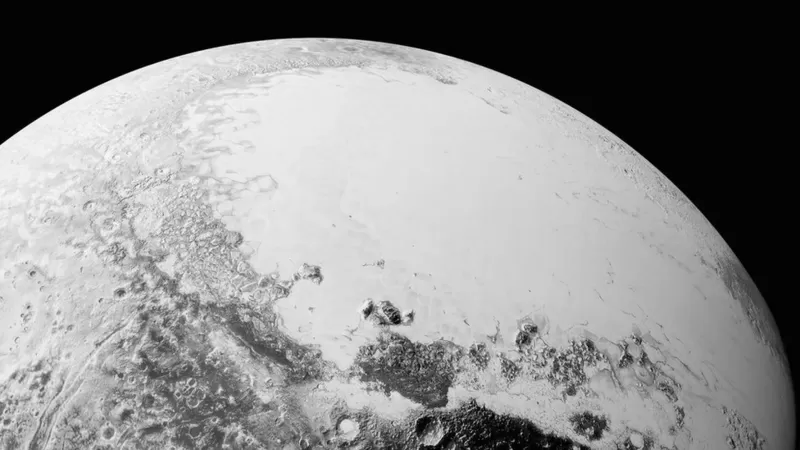Beyond Pluto: Evidence for a Ninth Planet in the Solar System

Is there a tenth planet in our solar system?
Astronomers believe that there is a planet larger than Earth located in the far reaches of the solar system, which may change astronomy theories related to the formation of the solar system.
Since astronomer Scott Sheppard of the Carnegie Institution for Science in Washington, and his collaborator Chad Trujillo of Northern Arizona University published a scientific study on suspicions of the existence of an invisible planet in 2014, evidence has continued to emerge gradually to prove this theory, according to the British newspaper The Guardian. .
When asked how convinced he is that the new world, which he calls Planet X (even though many other astronomers call it Planet 9), really does exist, Sheppard says only: "I think it likely does."
Astronomy circles are awaiting confirmation of evidence of the existence of such a new world through a giant modern telescope called "Vera C. Robin", after the astronomer who discovered in the seventies some of the first evidence of the existence of dark matter, which constitutes a large part of the mass of the universe .
The new astronomical observatory is scheduled to start working in 2022, when the Rubin telescope can clearly find the planet or at least provide circumstantial evidence of its existence.
While the discovery of the planet would be a triumph for astronomers, it would also be a disaster for the existing theory of how the solar system came to be .
Scott Sheppard says that the discovery of this planet would change everything we thought we knew about the formation of planets in general, especially in the absence of any theory explaining how a large planet can form far from the sun .
While the distant solar system is still a mysterious and unknown place, it contains many mysteries and a huge amount of unknown astronomical bodies that start from the borders of the orbit of the planet Neptune , which is about 30 times the Earth's distance from the sun, or about 30 astronomical units.
However, by the end of the 20th century, astronomers began finding infinitesimal worlds beyond Neptune using larger and newer telescopes, and those discovered were all smaller than Pluto and were dubbed dwarf planets.
Until 2005, astronomer Mike Brown of the California Institute of Technology discovered the new planet Eris, which is about the size of Pluto and possibly larger, which prompted NASA to announce the discovery of Planet No. 10 in the solar system.
But after about a year, the International Federation of Astronomers decided that Pluto and Eris were too small to call them a planet to call them dwarf planets, so the solar system returned to consist of 8 planets: Mercury, Venus, Earth, Mars, Jupiter, Saturn, Uranus, and Neptune.
In 2012, the first clues to the existence of Planet Nine began to emerge again, when Sheppard and Trujillo were observing celestial bodies using the Cerro Tololo Observatory in Chile.

Several celestial bodies were found, but one planet in particular stood out and was cataloged as VP113 2012, then nicknamed Planet Biden - after US Vice President Joe Biden at the time . This new planet does not approach in its orbit more than about 80 astronomical units from the sun, while it does not move away from 440 astronomical units from the center of the orbit, which means that it follows an elliptical orbit in its journey around the sun.
And it was not the most strange thing. By coincidence, its orbit seemed very similar to the orbit of another distant celestial body known as Sedna, which was discovered by astronomers at Yale University in 2003 and rotates in an elliptical shape as well. Its farthest point from the sun was about 937 astronomical units , while its closest point to the sun was 76 astronomical units.
Astronomer Scott Sheppard says that astronomical objects such as "Sedna" and "Biden" cannot rotate in such eccentric orbits. "Instead, computer simulations confirmed that the two planets orbit much closer than that, but they were moved away from those orbits." due to gravitational interactions with the larger planets.
The strange thing is that the two elliptical orbits are subject to the same orbital motion in an approximate manner, and are similar to the other orbits of the planets close to them. The only thing scientists can think of to explain this is a much larger planet.
Astronomers conducted some astronomical calculations that revealed the possibility of a planet that is between two and 15 times larger than Earth , and is located in an orbit around the sun between 250 and 1,500 astronomical units.
The results of this study were published in the scientific journal Nature in March 2014, and interest in Planet 9 began to sweep the astronomer world.
In 2015, a number of scientists, including Sheppard and Trujillo, discovered Planet 2015 TG387 and dubbed it the "Goblin Planet".
In 2016, astronomers at Caltech University in California published their own analysis of this study about the size and distance of the planet, and they also suggested an area in space in which the planet could be found, but discovering this planet is like searching for a needle in A haystack, and no current telescope will be able to find it.
But maybe the Rubin telescope can spot this planet. The Rubin Observatory, which is nearing completion, is the "sky-gobbling monster".
While most telescopes take months or years to scan the entire sky in search of celestial bodies, the Rubin telescope will be able to accomplish the task in only 3 nights, which means monitoring moving celestial bodies frequently at frequent intervals.
The Rubin telescope is scheduled to open its giant eye to the sky for the first time later this year, before it officially opens several years later.
"This survey will change the science of the solar system that we know about," says astronomer Scott Sheppard. "If Planet 9 is in the solar system, the Rubin telescope should see it."

Even if the telescope fails to see the planet directly, it will discover many more distant small worlds from which the planet's location can be determined more precisely, which helps narrow the search area. If Planet 9 is discovered there, the consequences for astronomical theories will be dire.
Most astronomers currently believe that the solar system was born 4.6 billion years ago from a huge cloud of gas and dust known as the solar nebula, and it attracted most of the solar nebula's material to its center, where the sun was formed.
It is believed that small particles of what remained of matter accumulated with a few of them afterwards, forming larger and larger bodies, until they turned into the eight planets, and what remained of them turned into moons , asteroids and comets , and this means that there is not enough raw material from that nebula to form A large planet in the far reaches of the solar system.
To explain the theory of the emergence of Planet 9, some astronomers indicate that this planet was destined to become a giant gas planet like Jupiter or Saturn , but due to gravitational interactions , the growth of this planet stopped and was thrown to the farthest part of the solar system.
Astronomer Jacob Schultz of Durham University questions this theory, saying: “This is possible, but it requires a lot of things to happen, because gravity alone cannot do that task, and instead, there must be a series of interactions and other attractions to put the planet in An orbit that cannot return to the place where it was first formed."
Schultz suggests instead that the space object in question is not a planet, but a black hole.
And if that were the case, even the new Rubin telescope wouldn't be able to see and detect it, because black holes don't emit any light at all - they simply swallow light and whatever else is going on inside them.
Scholz's suggestion that this object is a black hole falls under a theory that has not yet been proven about the formation of a large number of black holes that formed shortly after the formation of the universe.
But for the time being, most astronomers seem to go along with the idea of a large planet in the solar system, waiting to be discovered in the next few years.
Source: websites

